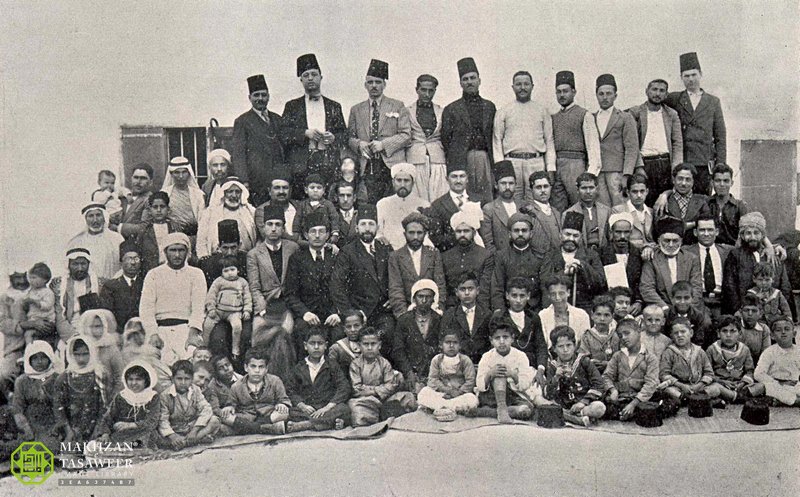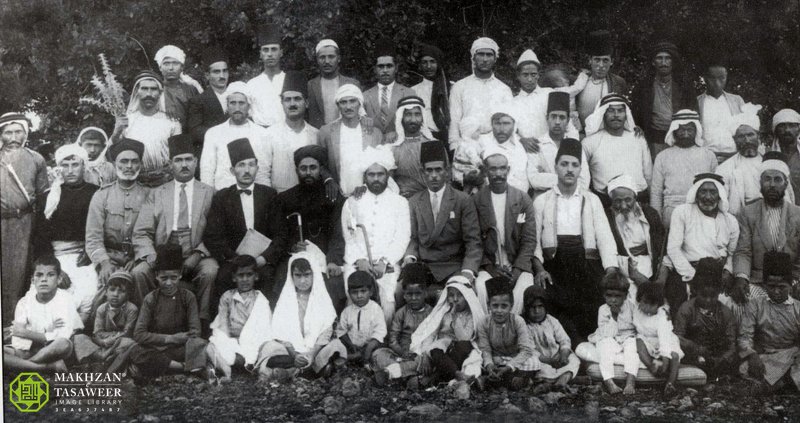A series looking at pioneer missionaries and devotees of the Ahmadiyya Muslim Jamaat who gave precedence to faith over the world.
Awwab Saad Hayat, Al Hakam

The early missionaries of the Ahmadiyya Community gained unprecedented success in the field of polemics and proved the truthfulness of Islam and the Holy Quran against Christian missionaries and Muslim scholars too. However, their arguments and proofs were met with the same response that enemies of truth typically resort to.
In December 1927, Hazrat Maulana Jalaluddin Shamsra, a missionary of the Ahmadiyya Muslim Jamaat in Damascus, was viciously attacked with a dagger by an opponent, causing severe injuries.
After a long recovery and having fully healed, on 9 March 1928, the French Mandate in Syria ordered him to leave the country, a move instigated by Muslim scholars at the time. He reported back to Hazrat Khalifatul Masih IIra in Qadian about the brewing situation via telegram. Huzoorra thus instructed him to move to the port of Haifa in Palestine.
Sayyid Munir al-Hussni Sahib was appointed as his acting amir in Damascus while Jalaluddin Shams Sahib reached Haifa on 17 March 1928. Thus, the foundation of the Ahmadiyya Muslim Community’s Palestine mission was laid.
From the fourth volume of Tarikh-e-Ahmadiyyat onwards, a brief overview of the Jamaat’s activities in the first 25 years of the Holy Land emerges as follows:
Initially, there was strong opposition to the missionary origination here, but with the help of Allah, Hazrat Maulana Jalaluddin Shamsra was successful in establishing a community in Haifa.
In Haifa, while discussions and debates with Muslims, Baha’is and Christians continued, the opposition and hostility of opposing scholars and religious elders also intensified. However, this proved to be a catalyst in the growth of the local Ahmadiyya community.
Ahmadis were also subjected to oppression and violence. During this period, civil unrest erupted between Jews and the local Muslim population in Haifa, at times resulting in bloodshed. When it became known that rioters wanted to attack the Ahmadiyya missionary’s house, Maulana Jalaluddin Shamsra was forced to move to another house.
Mahmood Mosque in Kababir, Haifa
On 3 April 1931, Maulana Jalaluddin Shamsra laid the foundation of the Mahmood Mosque in Kababir, which is the first Ahmadiyya mosque in the Arab world.
The roof of the mosque was yet to be built when Jalaluddin Shamsra was given his new posting. All the Ahmadi men, women and children of Kababir participated in the construction of this mosque.
Maulana Jalaluddin Shamsra remained in Palestine until 29 September 1931. During his stay, two permanent local jamaats were established in Haifa and Tiberias, and the message of Ahmadiyyat reached important places in the Arab world – such as Baghdad, Mosul, Beirut, Homs, Hama, Latakia, and Amman – through this missionary’s letters and efforts.

Maulana Abul Ata Sahib
While Maulana Jalal-ud-din Shamsra was still in Haifa, Maulana Abul Atara, at the behest of Hazrat Khalifatul Masih IIra, left Qadian on 13 August 1931 and reached Haifa on 4 September 1931. Maulana Shamsra handed over the charge of the Palestine mission to him and returned to Qadian on 20 December 1931.
Maulana Abul Atara stayed there from September 1931 to the end of January 1936. During this time, this Ahmadiyya mission gained a firmer foothold than before.
The Mahmood Mosque in Kababir saw its construction reach completion.
In 1930, Maulana Shamsra started a small school in which the Holy Quran was taught to boys and girls. It was formally inaugurated in the form of an Ahmadiyya school by Maulana Abul Atara on 1 January 1934. He, himself, was the first headmaster of this school.
In addition, he started the first Ahmadiyya printing press in Kababir under the name Al-Matba‘ah al-Ahmadiyyah, which was inaugurated on 6 March 1935, and the first Arabic translation of the Promised Messiah’sas Da‘wat-ul-Haq was published in it.
During his time in Palestine, there was also a series of written and oral debates with Muslim scholars and Christian preachers, in which Allah gave victory to Islam Ahmadiyyat, and the message of truth reached many people. During this time, Maulana Abul Atara also visited Cairo, Ras El-Bar, Damietta, and Alexandria in Egypt.
In addition to Christians, he also invited Jews to Islam and published a tract in Hebrew for them. This was the first time the Jewish people had received a message from Muslims in the Hebrew language, and they were surprised that they were being called to Islam in Hebrew.
One of the special features of his stay was that instead of publishing a tract or magazine occasionally, he set the practice of a regular magazine that was published at a scheduled time. It was published as a quarterly magazine called Al-Bushra al-Islamiyah al-Ahmadiyyah – which was later changed to Al-Bushra in January 1935 – and proved to be the most effective means of spreading the message of Islam and Ahmadiyyat in the length and breadth of the Arab world.
In addition to the regular quarterly or monthly magazine, he was also able to publish some other valuable literature.
During his stay, new local jamaats were established in Umm al-Fahm and Mawqif Aarah, and the number of Ahmadis increased in Kababir, Haifa and Barja areas.
Maulana Muhammad Salim Sahib
Maulana Abul Atara handed over the charge to Maulana Muhammad Salim Sahib, and went back to Qadian on 24 February 1936 via Syria and Iraq.
To reach Palestine, Maulana Muhammad Salim Sahib left Qadian on 4 January 1936, and reached Haifa on 27 January 1936. Just a few weeks after he took charge, a general strike broke out in Palestine due to the mutual conflict between Arabs and Jews. This strike continued for six months. It soon took the form of a riot. However, he regularly kept the series of teaching and educating locals in Dar-ul-Tabligh, Kababir. He handled the tiresome work of editing Al-Bushrah in a beautiful style and manner. He took an interest in the development and well-being of Kababir’s local Ahmadiyya School and also held debates with scholars of the prestigious Al-Azhar University of Egypt, living or visiting Palestine.
He also had some debates with some Christian priests. In his time, many blessed souls also entered the fold of Jamaat. He was also able to translate or re-publish some famous books.
Chaudhary Muhammad Sharif Sahib
Maulana Muhammad Salim Sahib returned after fulfilling his assigned duties of tabligh for about two years on 10 March 1938. Then, Hazrat Khalifatul Masih IIra sent Chaudhary Muhammad Sharif Sahib to Palestine.
He left Qadian on 7 September 1938, and reached Haifa on 24 September 1938. He remained engaged in tabligh in the Arab world for roughly 18 years, and then returned to Rabwah, the then-new headquarters of the Community, on 15 December 1955.
His period of stay in the Holy Land passed in very trying circumstances. The conflict between Arabs and Jews took a more delicate form than before. During this time, a plan was also made to kill him, which failed. When the civil war between Arabs and Jews in Palestine reached its climax, the United Nations announced the decision to divide Palestine in November 1947, and later on, in 1948, the Israeli government was established and the series of killing each other and looting was on the rise everywhere. Where thousands of innocent Arabs were killed and millions were displaced. Haifa and Kababir were cut off from the rest of the country and several local jamaats were forced to migrate.
Sheikh Noor Ahmad Manir Sahib and Maulana Rashid Ahmad Chughtai Sahib
The final decision of the division of Palestine had just been taken when, by the order of Hazrat Khalifatul Masih IIra, Maulana Sheikh Noor Ahmad Manir and Maulana Rashid Ahmad Chughtai left for Palestine respectively on 13 October 1945, and 23 October 1946, for tabligh in the Arab world.
Sheikh Noor Ahmad Manir, after fulfilling the duty of tabligh in Palestine for a few months, reached Syria on 17 September 1946. Apart from re-establishing the Ahmadiyya Community in Syria. During his stay, Palestinian Ahmadis came to Damascus as refugees in extremely poor conditions, and he also arranged their settlement. In this regard, Damascus’s local jamaat showed a great example of sincerity and sympathy and provided every possible assistance to the Palestinian Ahmadi refugees in particular and other refugees in general. He returned to Rabwah on 17 December 1949.
After one year of Maulana Rashid Ahmad Chughtai’s arrival in Palestine, the situation in Palestine had become very delicate. Therefore, Chaudhry Muhammad Sharif sent him to establish a new mission in East Jordan on 3 March 1948.
Praise for the missionary’s wise decision
Hazrat Khalifatul Masih IIra praised this timely action of Chaudhry Muhammad Sharif Sahib, the missionary in charge, and said that just as East Punjab had suffered greatly, a similar fate befell Palestine due to the onslaught by the Jews; and our Jamaat found itself amid this perilous situation. Some members of Haifa’s jamaat had relocated to Damascus ahead of the riots, while details about the others remained elusive. Realising the urgency of the circumstances, Chaudhry Muhammad Sharif Sahib, the missionary in charge, portrayed astuteness and promptly dispatched one of the preachers to East Jordan. Given the uncertainty encircling our circumstances, he instructed the preacher to establish a new centre in the region. This strategic action mirrored the approach adopted when departing from Qadian. (Al Fazl, 5 December 1948, p. 3)
Some of the services of Chaudhry Muhammad Sharif Sahib
The Ahmadiyya Printing Press (Kababir) was abandoned and locked up. He got it fixed in November 1938 and started publishing the magazine (Al-Bushrah) from it. It continued to be published regularly under his editorship till his stay.
The Ahmadiyya Printing Press and Ahmadiyya Library were built temporarily, which he rebuilt on solid grounds from scratch.
He elevated the standards of the Ahmadiyya Kababir School, published many new books, and translated some.
Among some of the other important services that Chaudhry Muhammad Sharif Sahib performed during his time in Palestine, he also challenged the Haifa Islamic Law Court’s decision regarding the Islamic faith of Ahmadis. He took the matter to the Supreme Islamic Council (Jerusalem), which issued a directive to all courts that the Ahmadiyya community is a Muslim sect.
In January 1947, he challenged the Patriarch of Antioch in particular, and the patriarchs and bishops of Palestine and Syria in general, to a public and written debate on the controversial issues between Islam and Christianity. This challenge was published in newspapers in Iraq, Egypt, Syria, and Lebanon, but they did not dare to come forward.
He also had debates with the leader of the Baha’is, Shoghi Effendi Rabbani.
He also toured Egypt, Syria, Jordan, Lebanon, and Iraq. Through his efforts, not only did the early local jamaats of the Arab world grow, but new local jamaats were also established in Sudan, Ethiopia, Aden,
Kuwait, Bahrain, and North Africa
After his return, Maulana Jalaluddin Sahib Qamar was appointed as the in-charge missionary in the Palestine Mission. He continued to perform the duty of preaching till December 1964.
This is the briefest overview of some of the efforts of the Ahmadiyya Muslim Community during the first quarter-century of its history in the Holy Land.
May Allah grant the Jamaat to continue its journey of service and goodness to the Muslim ummah and humankind in general. Amin.

